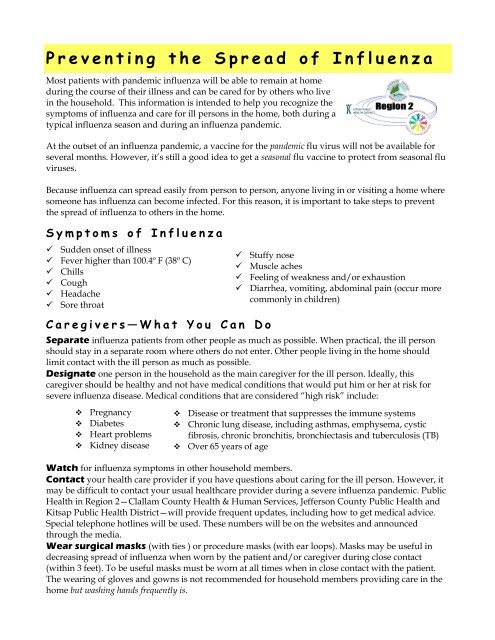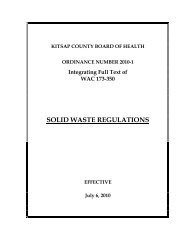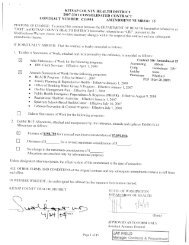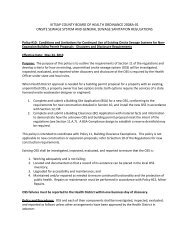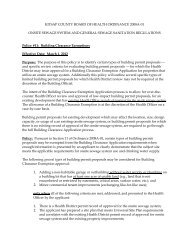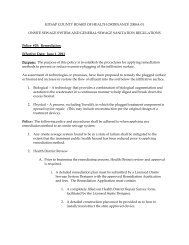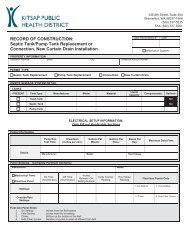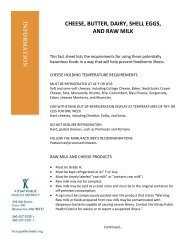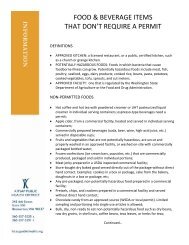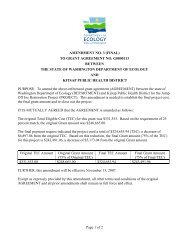Pandemic Flu - Kitsap Public Health District
Pandemic Flu - Kitsap Public Health District
Pandemic Flu - Kitsap Public Health District
You also want an ePaper? Increase the reach of your titles
YUMPU automatically turns print PDFs into web optimized ePapers that Google loves.
P r e v e n t i n g t h e S p r e a d o f I n f l u e n z a<br />
Most patients with pandemic influenza will be able to remain at home<br />
during the course of their illness and can be cared for by others who live<br />
in the household. This information is intended to help you recognize the<br />
symptoms of influenza and care for ill persons in the home, both during a<br />
typical influenza season and during an influenza pandemic.<br />
At the outset of an influenza pandemic, a vaccine for the pandemic flu virus will not be available for<br />
several months. However, it’s still a good idea to get a seasonal flu vaccine to protect from seasonal flu<br />
viruses.<br />
Because influenza can spread easily from person to person, anyone living in or visiting a home where<br />
someone has influenza can become infected. For this reason, it is important to take steps to prevent<br />
the spread of influenza to others in the home.<br />
S y m p t o m s o f I n f l u e n z a<br />
Sudden onset of illness<br />
Fever higher than 100.4º F (38º C)<br />
Chills<br />
Cough<br />
Headache<br />
Sore throat<br />
Stuffy nose<br />
Muscle aches<br />
Feeling of weakness and/or exhaustion<br />
Diarrhea, vomiting, abdominal pain (occur more<br />
commonly in children)<br />
C a r e g i v e r s — W h a t Y o u C a n D o<br />
Separate influenza patients from other people as much as possible. When practical, the ill person<br />
should stay in a separate room where others do not enter. Other people living in the home should<br />
limit contact with the ill person as much as possible.<br />
Designate one person in the household as the main caregiver for the ill person. Ideally, this<br />
caregiver should be healthy and not have medical conditions that would put him or her at risk for<br />
severe influenza disease. Medical conditions that are considered “high risk” include:<br />
Pregnancy<br />
Diabetes<br />
Heart problems<br />
Kidney disease<br />
Disease or treatment that suppresses the immune systems<br />
Chronic lung disease, including asthmas, emphysema, cystic<br />
fibrosis, chronic bronchitis, bronchiectasis and tuberculosis (TB)<br />
Over 65 years of age<br />
Watch for influenza symptoms in other household members.<br />
Contact your health care provider if you have questions about caring for the ill person. However, it<br />
may be difficult to contact your usual healthcare provider during a severe influenza pandemic. <strong>Public</strong><br />
<strong>Health</strong> in Region 2—Clallam County <strong>Health</strong> & Human Services, Jefferson County <strong>Public</strong> <strong>Health</strong> and<br />
<strong>Kitsap</strong> <strong>Public</strong> <strong>Health</strong> <strong>District</strong>—will provide frequent updates, including how to get medical advice.<br />
Special telephone hotlines will be used. These numbers will be on the websites and announced<br />
through the media.<br />
Wear surgical masks (with ties ) or procedure masks (with ear loops). Masks may be useful in<br />
decreasing spread of influenza when worn by the patient and/or caregiver during close contact<br />
(within 3 feet). To be useful masks must be worn at all times when in close contact with the patient.<br />
The wearing of gloves and gowns is not recommended for household members providing care in the<br />
home but washing hands frequently is.


